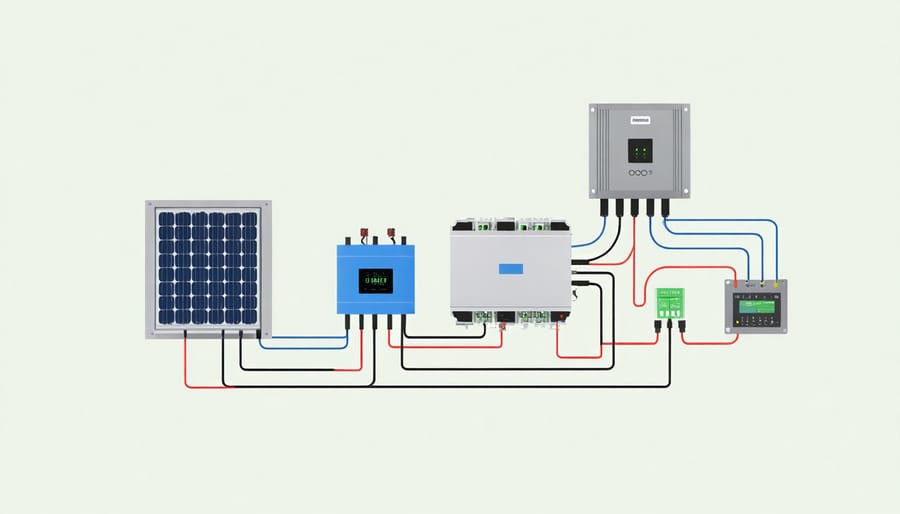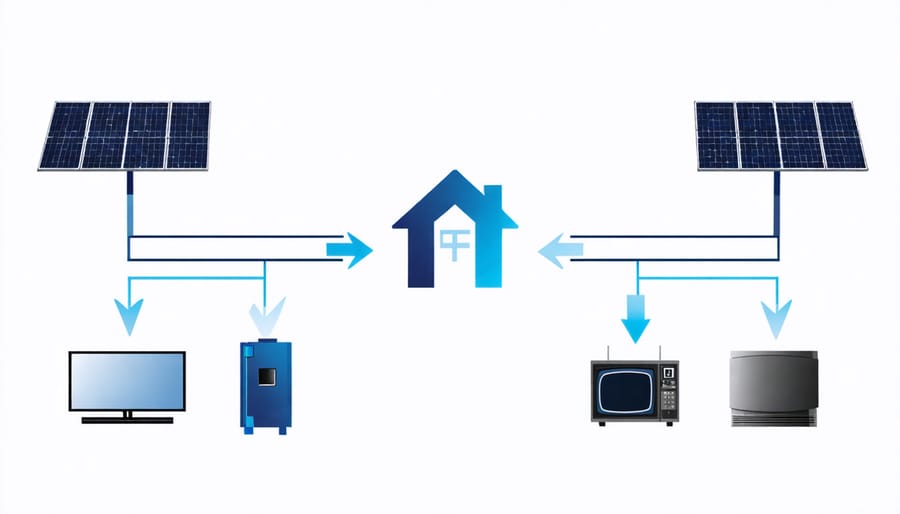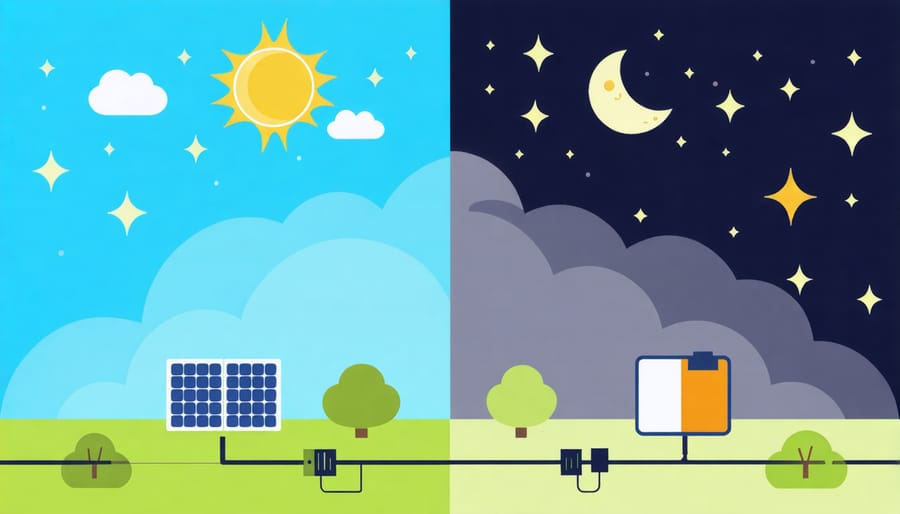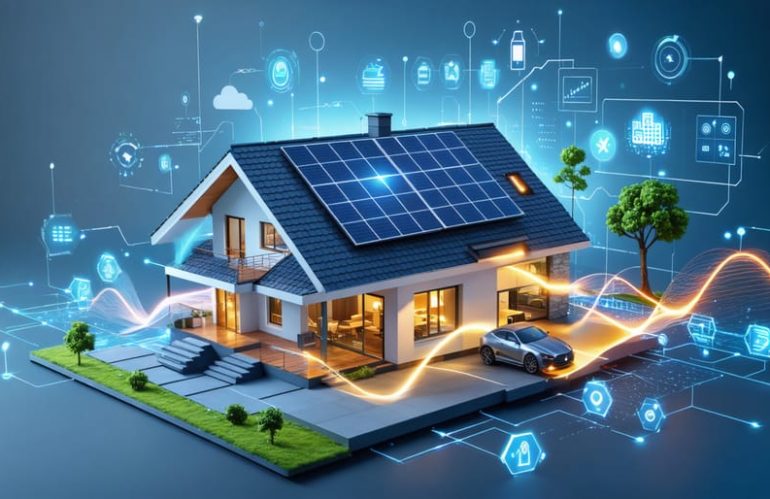Battery energy storage systems (BESS) represent the future of home energy management, transforming how we store and use power from solar panels and the grid. By understanding the core components and connections within a BESS diagram, homeowners can make informed decisions about their energy independence journey. These systems integrate seamlessly with existing electrical infrastructure, storing excess solar power during sunny days and providing reliable backup during outages or peak demand periods.
A well-designed battery storage system acts as the bridge between your power generation sources and daily energy needs. Modern BESS configurations incorporate sophisticated power electronics, intelligent controls, and safe battery technologies to maximize efficiency while minimizing maintenance requirements. Whether you’re considering a new installation or upgrading your current setup, grasping the fundamentals of BESS architecture helps ensure you select the right solution for your home’s unique energy profile.
Let’s explore the essential elements of a battery energy storage system diagram and how these components work together to create a reliable, sustainable power solution for your home.
Understanding Your Home Battery Storage System
Core Components Explained
A battery energy storage system consists of three essential components working together seamlessly. The battery bank, typically made of lithium-ion batteries, stores excess electricity generated by your solar panels or drawn from the grid during off-peak hours. Think of these batteries as your home’s energy reservoir, ready to power your needs when the sun isn’t shining or during power outages.
The inverter serves as the system’s translator, converting DC power stored in the batteries into AC power that your home appliances can use. Modern inverters are highly efficient and often come with smart features that help maximize your energy savings.
The control system is the brains of the operation, managing how and when power flows between your solar panels, batteries, and home. This intelligent controller monitors your energy usage patterns, battery levels, and grid conditions to optimize performance. It automatically switches between power sources, ensures your batteries maintain optimal charge levels, and can even communicate with your smart home devices to enhance energy efficiency.
These components work in harmony to provide reliable backup power while helping you reduce your energy bills and carbon footprint.

How Energy Flows Through Your System
Energy flows through your battery storage system in a beautifully simple way. Starting at your solar panels, sunlight is converted into electricity that travels through your inverter. This clean energy then has two possible paths: it can either power your home directly or be stored in your battery system for later use.
When your solar panels produce more power than you need, the excess electricity charges your batteries, like filling up a savings account for a rainy day. During peak sunlight hours, you’ll often generate more than enough power to both run your home and store energy for later.
As evening approaches or during cloudy weather, your system automatically switches to battery power. Your stored energy seamlessly takes over, powering your lights, appliances, and electronics without any interruption. If your batteries run low, your system can draw power from the grid as a backup.
This continuous flow ensures you’re making the most of your solar investment while maintaining reliable power throughout the day and night. It’s like having your own personal power plant, working silently to keep your home running efficiently.

Smart Integration with Your Solar Setup

Daytime Energy Collection
During peak sunlight hours, your independent solar panels often generate more electricity than your home immediately needs. This excess energy presents a perfect opportunity for storage and later use. The battery energy storage system efficiently captures this surplus power, preventing it from being sent back to the grid where you might receive minimal compensation.
The process begins when your solar panels convert sunlight into electricity during daylight hours. This DC power flows through your inverter and is distributed to meet your home’s immediate energy needs. When production exceeds consumption, the sophisticated battery management system directs the excess energy into your storage batteries, typically lithium-ion units designed for home use.
Modern battery systems can monitor real-time energy production and consumption, automatically adjusting charging rates to optimize storage capacity. This smart technology ensures your batteries charge efficiently during peak production hours, typically between 10 AM and 2 PM when solar generation is at its highest.
Your system will continue storing energy until the batteries reach full capacity or the sun’s intensity diminishes. This stored power becomes invaluable during evening hours, cloudy days, or grid outages, providing you with reliable, clean energy when you need it most.
Nighttime Power Management
When the sun sets, your battery energy storage system transitions seamlessly to power your home through the night. This process, guided by advanced smart home power management, ensures your lights stay on and appliances keep running without interruption.
During nighttime hours, the system automatically draws from the energy stored in your batteries, which was collected during peak sunlight hours. The inverter converts the stored DC power back into AC power, matching your home’s electrical needs. This conversion happens in real-time, maintaining a stable power supply that feels no different from grid electricity.
Your system’s smart controller continuously monitors your home’s energy consumption, releasing stored power efficiently to ensure it lasts through the night. On typical evenings, a well-designed battery system can easily power essential appliances like refrigerators, lighting, and security systems. Many systems even allow you to prioritize which devices receive power during extended periods without solar generation.
For added peace of mind, the system maintains a connection to the grid as backup, seamlessly switching over if battery levels run low. This intelligent power management means you’ll rarely notice the transition between solar, battery, and grid power, ensuring comfortable, uninterrupted living even after sunset.
Maximizing Your Energy Independence
Optimal Charging Patterns
To get the most from your battery energy storage system, following optimal charging patterns is essential. The best practice is to maintain your battery charge level between 20% and 80% during regular use, which helps extend battery life and maintain efficiency. Think of it like keeping your phone battery healthy – avoiding complete discharge and constant top-ups.
During off-peak hours, when electricity rates are lowest, schedule your system to charge fully. This stored energy can then be used during peak hours when rates are highest, maximizing your cost savings. Many modern systems come with smart controllers that automatically manage these charging cycles.
For homes with solar panels, prioritize using solar energy to charge your batteries during sunny days. The system should be programmed to store excess solar power first, only drawing from the grid when necessary. This approach ensures you’re maximizing your renewable energy usage while minimizing grid dependency.
Seasonal adjustments are also important. In winter, when solar production is lower, you might want to maintain higher average charge levels. During summer, with abundant sunlight, you can operate within a wider charge range.
Backup Power Benefits
One of the most valuable features of a battery energy storage system is its ability to provide reliable backup power during grid outages. When the power goes down, your battery system automatically kicks in within milliseconds, keeping your essential appliances running without interruption. Unlike traditional generators, there’s no need to manually start the system or deal with noisy machinery and fuel storage.
During an outage, your battery system can power critical loads like refrigerators, medical equipment, home office equipment, and lighting. Many systems allow you to customize which appliances receive backup power, helping you maximize battery life when it matters most. With proper sizing, a battery system can keep your essential devices running for several hours or even days, depending on your energy usage and battery capacity.
This reliable backup solution brings peace of mind, especially in areas prone to severe weather or unreliable grid service. The system also maintains power quality, protecting sensitive electronics from harmful voltage fluctuations that often occur during grid instability.
Money-Saving Strategies
To maximize your battery energy storage system’s financial benefits, focus on strategic energy usage during peak rate periods. Most utility companies charge higher rates during high-demand hours, typically between 4 PM and 9 PM. Program your system to automatically switch to stored battery power during these expensive periods, effectively avoiding premium rates.
Consider implementing a “load shifting” strategy by charging your batteries during off-peak hours when electricity rates are lowest, usually late at night or early morning. Then, use this stored energy during peak periods. This simple adjustment can lead to significant savings on your monthly electricity bills.
Many modern battery systems come with smart apps that help you track real-time energy prices and consumption patterns. Use these tools to optimize your charging and discharging schedules. Some systems even offer automated features that learn your household’s energy usage patterns and adjust accordingly.
For maximum savings, combine your battery storage with time-of-use rates from your utility provider. This rate structure rewards you for using electricity during off-peak hours, multiplying your potential savings when paired with strategic battery use.
Battery energy storage systems represent a significant step forward in home energy management, offering a practical solution for energy independence and cost savings. By understanding how these systems work through detailed diagrams, you can make informed decisions about implementing this technology in your home. The benefits are clear: reduced electricity bills, increased energy independence, and a smaller carbon footprint.
With proper installation and integration, a battery storage system can protect your home from power outages while maximizing the use of renewable energy sources. This technology isn’t just about storing power – it’s about smart energy management that adapts to your household’s unique needs and consumption patterns.
As electricity costs continue to rise and grid reliability becomes increasingly uncertain, now is the perfect time to consider installing a battery storage system. The initial investment is offset by long-term savings and increased property value, making it a sound financial decision for many homeowners.
Take the next step toward energy independence by consulting with qualified installers who can assess your specific needs. They can help you design a system that perfectly matches your home’s energy requirements and goals. Remember, every home that adopts battery storage technology contributes to a more sustainable and resilient energy future.
Don’t wait for the next power outage or rate hike to take action. Start exploring your battery storage options today and join the growing community of energy-independent homeowners.









